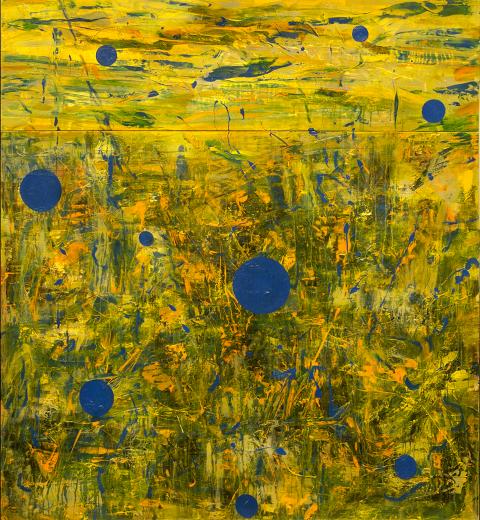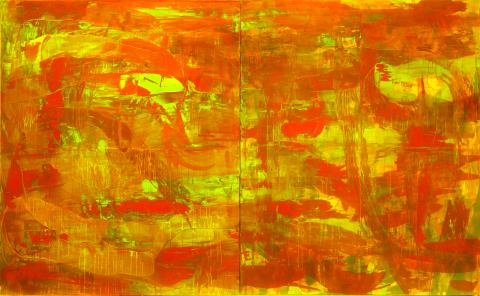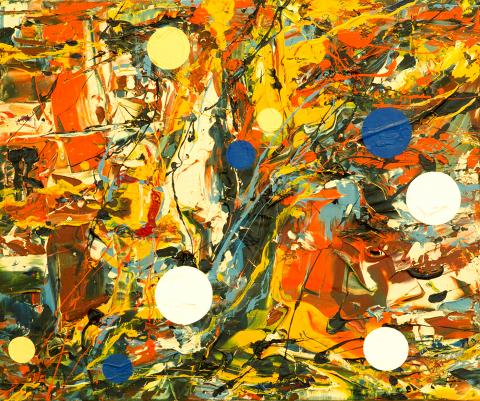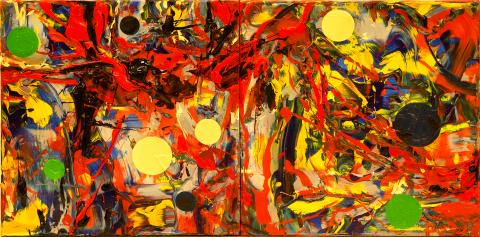It was less than a week after having a 3cm tumor removed from her head that Ava Hsueh (薛保瑕) quit her job as director of Taichung’s National Taiwan Museum of Fine Arts to devote her life to her art.
“The wonderful pearl,” as she euphemistically calls the growth that was removed in 2009, was a tangible reminder that “I was working too hard,” she says with a laugh while discussing Reforming Reality (現實革新), the appropriately titled first work she created following the operation.
Furiously applied horizontal and vertical swaths of impasto blood reds, habanero oranges and pyocyanin greens overlap and bleed down the surface of the canvas, the colors and brushstroke arrangement an allusion to the growth and its removal. The Margins of Movement (移動的邊緣), a diptych that faces Reforming Reality trades in the fiery reds for ultramarine, a reference to the “blue, blue light in the elevator” she saw when she was being wheeled to the intensive care unit after the surgery.

Photo courtesy of Tina Keng Gallery
“I see the light, and I think to myself the world is here and I’m alive,” she says.
These two formative and highly personal statements are tucked away, somewhat oddly, in the basement space of Tina Keng Gallery (耿畫廊), and serve as an ideal place to begin looking at the 29 mostly monumental paintings on display in Non-Zero Point (非零點). The title, like the later works on display, refers to painting as an infinite collection of points that are bound up in cycles and numbers, color and form, beginnings and endings. Her later work is also an attempt to formulate a new language of abstraction.
Working method

Photo courtesy of Tina Keng Gallery
Hsueh’s reputation looms fairly large in Taiwan’s small world of abstract artists. Educated at New York’s Pratt Institute and with a PhD in art history from New York University (where she wrote her thesis on post-1980s abstract art), she stands with other foreign-educated abstract artists — Tsong Pu (莊普), who studied in Spain and Chu Teh-i (曲德義), France — who returned to Taiwan in the 1980s.
Hsueh’s ebullient temperament resembles the busyness of her paintings. When demonstrating her working process, she lopes back and forth in front of the canvas, an imaginary paintbrush in hand ejaculating fictitious strands of acrylic on to the picture plane. Discussing the juxtaposition between the background of expressive brushstrokes and the solid points at the foreground (found mainly in her 2013 works displayed on the gallery’s first and second floor), she bounds towards and away from the canvas, now focusing on parts, now focusing on the whole. Like the act of creating these paintings, her gestures make explicit, the viewing experience shouldn’t be static.
The seemingly turbulent arrangement of superimposed layers of color allows for an interesting contrast with the nine dots of solid coloring in the foreground. In the interstices of this built-up impasto coloring, scraped canvas can be discerned underneath, apertures of texture that draw us into the picture’s surface.

Photo courtesy of Tina Keng Gallery
One looks at the paintings and thinks action, spontaneity, perhaps even chaos. But for Hsueh, a painting’s narrative logic unfolds slowly, and only after she picks up the brush. No preliminary drawings are fashioned. Earlier brushstrokes dictate the placement of later ones in a series of problems that are resolved by the actions of the painter. For Hsueh, there is inevitability to her work, though it appears spontaneously rendered.
“It’s a real struggle,” she says of the intense concentration required to finish the nine variously sized dots.
“Sometimes tears well up in my eyes.”

Photo courtesy of Tina Keng Gallery
The juxtaposition between the action of the background and the geometric stasis of the foreground, the paintings serve to underscore the fragmentation, contingency and discontinuity of lived experience. Hsueh, of course, has experienced these vicissitudes; a beginning in which she builds up a framework subsumed visual language of the century-old tradition of abstract art.
Nothing if not critical
On first view, it would be easy to dismiss Hsueh’s recent paintings as Jackson Pollock rip-offs — much as critics dismissed the younger Pollock’s cubist works as Picasso rip-offs (later critics make much of Pollock’s copying as being important in his leap to abstract expressionism). But this might be too dismissive. (I did a close reading of Pollock’s flat and laminar “drippings with Hsueh’s impasto and tempestuous swaths, and found there to be little similarity on a microscopic level.) Steeped in the theory and history of abstract painting, her visual references to the tradition could form the basis of a thesis.

Photo courtesy of Tina Keng Gallery
Hsueh also takes up Jasper Johns’ challenge (echoing Duchamp), of forcing the viewer out of habitual ways of seeing. Or, as Johns says, “things that the mind already knows,” and consequently, “seen and not looked at, not examined.” But rather than doing this with everyday objects — targets, flags, numbers — as Johns did, Hsueh goes after the genre of abstract painting itself.
“What are the elements on the canvas that enable us to see that this is abstract art,” Hsueh asks rhetorically. Are they, as I at first thought, Pollock’s expressionist drips or throws of paint? Or is it the geometrically rendered everyday forms that Johns, following Kandinsky and others, ponders as part of the modernist search for objective holistic purity? By narrating both on the canvas, Hsueh hopes to elicit a freshness of seeing that cannot be expressed by either genre alone because we are habitually conditioned to perceive them in a particular way: That splatter over there? That’s Pollock. That circle? Johns.
The question is: Has she succeeded?
It’s difficult to say if you aren’t already deeply versed in the aesthetics of pictorial abstraction. It appears, though, that once theory took hold, Hsueh’s paintings became cerebral and lost the immediacy of those 2010 works painted following her surgery. Perhaps for the student of abstract art, these are worthy explorations and exercises, but for the rest of us not specialists in abstraction’s traditions and theories, they simply look like dotted Pollocks.

June 23 to June 29 After capturing the walled city of Hsinchu on June 22, 1895, the Japanese hoped to quickly push south and seize control of Taiwan’s entire west coast — but their advance was stalled for more than a month. Not only did local Hakka fighters continue to cause them headaches, resistance forces even attempted to retake the city three times. “We had planned to occupy Anping (Tainan) and Takao (Kaohsiung) as soon as possible, but ever since we took Hsinchu, nearby bandits proclaiming to be ‘righteous people’ (義民) have been destroying train tracks and electrical cables, and gathering in villages

Dr. Y. Tony Yang, Associate Dean of Health Policy and Population Science at George Washington University, argued last week in a piece for the Taipei Times about former president Ma Ying-jeou (馬英九) leading a student delegation to the People’s Republic of China (PRC) that, “The real question is not whether Ma’s visit helps or hurts Taiwan — it is why Taiwan lacks a sophisticated, multi-track approach to one of the most complex geopolitical relationships in the world” (“Ma’s Visit, DPP’s Blind Spot,” June 18, page 8). Yang contends that the Democratic Progressive Party (DPP) has a blind spot: “By treating any

This year will go down in the history books. Taiwan faces enormous turmoil and uncertainty in the coming months. Which political parties are in a good position to handle big changes? All of the main parties are beset with challenges. Taking stock, this column examined the Taiwan People’s Party (TPP) (“Huang Kuo-chang’s choking the life out of the TPP,” May 28, page 12), the Democratic Progressive Party (DPP) (“Challenges amid choppy waters for the DPP,” June 14, page 12) and the Chinese Nationalist Party (KMT) (“KMT struggles to seize opportunities as ‘interesting times’ loom,” June 20, page 11). Times like these can

Swooping low over the banks of a Nile River tributary, an aid flight run by retired American military officers released a stream of food-stuffed sacks over a town emptied by fighting in South Sudan, a country wracked by conflict. Last week’s air drop was the latest in a controversial development — private contracting firms led by former US intelligence officers and military veterans delivering aid to some of the world’s deadliest conflict zones, in operations organized with governments that are combatants in the conflicts. The moves are roiling the global aid community, which warns of a more militarized, politicized and profit-seeking trend